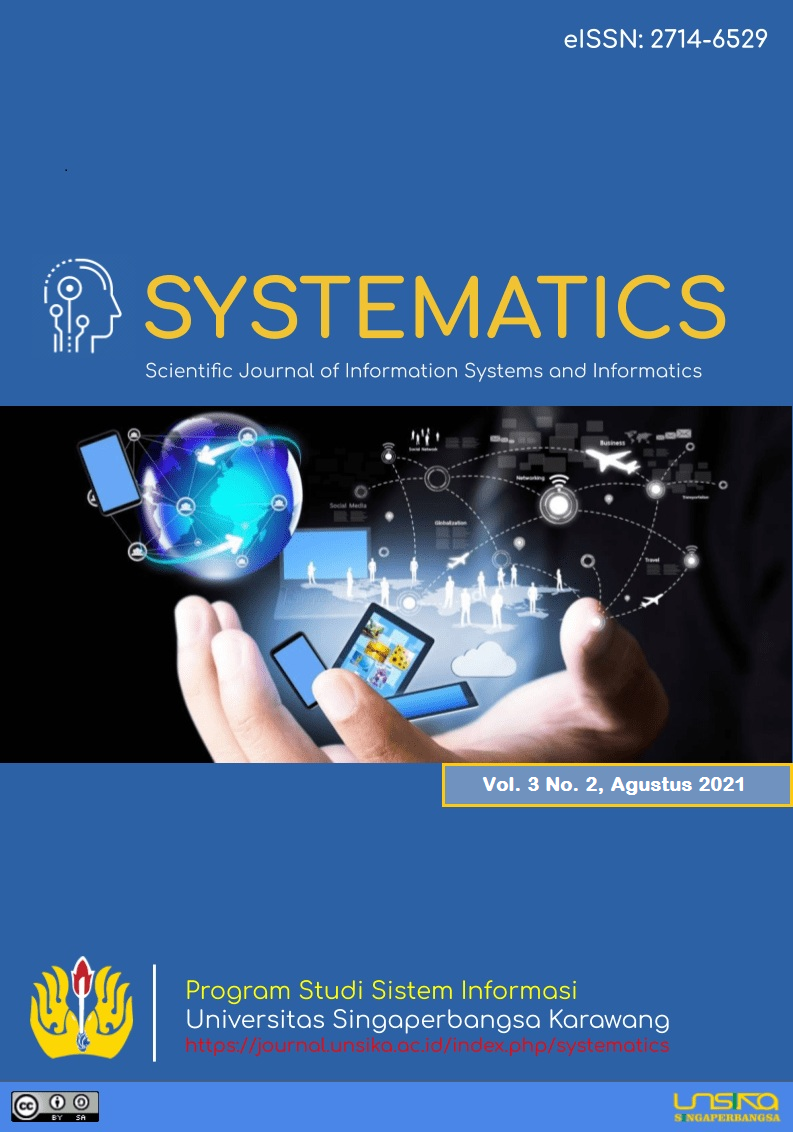WhatsApp Bot in Hadith Search Using The Full-text Indexes Method and Text Mining
Bot WhatsApp dalam Pencarian Hadits Menggunakan Metode Indeks Teks Lengkap dan Penambangan Teks
DOI:
https://doi.org/10.35706/sys.v3i2.5830Abstract
The WhatsApp application is now one of the most widely used media by all circles, from school children, professionals and even religious teachers use it. The ability of WhatsApp can be used by many fields in social life, such as phone calls, chats, groups and others. Because people are now accustomed to using WhatsApp, it can also be used to convey knowledge such as about hadith searches which are usually done by people who need information or knowledge about certain hadiths. This WhatsApp application will display the search results made by the searcher through the message sent. The message sent to this special number sends a word or several words in the message which will be processed by the system via the Restful API to the database. This system provides a random response to search results by displaying how many hadiths are related to the search.
Downloads
References
W. P. Review, “Muslim Population by Country 2021.” [Online]. Available: https://worldpopulationreview.com/country-rankings/muslim-population-by-country. [Accessed: 29-Nov-2021]
Kholis N, Pengantar Studi Al-Qur’an Dan Al-Hadits / Nur Kholis. Yogyakarta: Teras, 2008.
“Tentang WhatsApp.” [Online]. Available: https://www.whatsapp.com/about/?lang=id. [Accessed: 01-Dec-2021]
Yeboah J., and Ewur G. D, “The impact of Whatsapp messenger usage on students performance in tertiary institutions in Ghana,” Vol 5(6), J. Educ. Pract., 2014, pp. 157–164.
Aprilia S, “Sistem Informasi Absensi Berbasis Website Menggunakan API WhatsApp dengan Metodologi Incremental (Studi Kasus: SMP Negeri 29 Pekanbaru),” Vol 4(1), J. Appl. Informatics Comput., 2020, pp. 38–44.
Dewantya C. C., et al., “Pengembangan Aplikasi Employee Assistance Program Dengan Fitur Live Chat Menggunakan Whatsapp Api ( Studi Kasus : Pt Metrosolusindo ),” Vol 16, 2018, pp. 216–9436.
Parlika R., Pradika S. I., Hakim A. M., and Manab K. R. N, “Bot Whatsapp Sebagai Pemberi Data Statistik COVID-19 Menggunakan PHP, Flask, Dan MySQL,” Vol 1(2), J. Inform. dan Sist. Inf., 2020, pp. 282–293.
Didik P., and Man D. I, “Telaah Pembelajaran Al-qur'an Hadits Melalui Media Whatsapp Grup dalam Mengembangkan Keterampilan Membaca Al-qur'an Peserta Didik di MAN 2 Malang,” Vol 6 (4), Vicratina J. Pendidik. Islam, 2021, pp. 214–228.
Zainiyati, H. S., Munawaroh S., AlHana R., and Badriyah L, “Penerapan JIGSAW Learning Melalui Whatsapp untuk Memahami Materi Quran Hadits Surah Al-Humazah,” Vol 5, JALIE J. Appl. Linguist. Islam. Educ., 2021, pp. 25–51.
Navarro G., and Mäkinen V, “Compressed full-text indexes,” Vol 39(1), ACM Comput. Surv., 2007.
Zobel J., Moffat A., and Sacks-Davis R, “An Efficient Indexing Technique for Full-Text Database Systems,” Proc. 18th VLDB Conf., 1992, pp. 352–362.
Maier A., and Simmen D. E, “DB2 optimization in support of full text search,” Vol 24 (4), IEEE Data Eng. Bull., 2001, pp. 3–6.
Gunawan L. N., Anjarwirawan J., and Handojo A, “Aplikasi Bot Telegram Untuk Media Informasi Perkuliahan Program Studi Informatika-Sistem Informasi Bisnis Universitas Kristen Petra,” Vol 6(1), J. Infra Petra, 2018, pp. 921–921.
Abu Shawar B., and Atwell E, “Chatbots: are they really useful?,” Vol 22(1), LDV-Forum Zeitschrift für Comput. und Sprachtechnologie, 2007, pp. 29–49.
Kannan S., and Gurusamy V, “Preprocessing Techniques for Text Mining (PDF Download Available),” no. October 2014, 2014 [Online].
Downloads
Published
How to Cite
Issue
Section
License
Copyright (c) 2021 SYSTEMATICS

This work is licensed under a Creative Commons Attribution-ShareAlike 4.0 International License.
Authors who publish with this journal agree to the following terms:
- Authors retain copyright and grant the journal right of first publication with the work simultaneously licensed under a Creative Commons Attribution-ShareAlike 4.0 International License. that allows others to share the work with an acknowledgement of the work's authorship and initial publication in this journal.
- Authors are able to enter into separate, additional contractual arrangements for the non-exclusive distribution of the journal's published version of the work (e.g., post it to an institutional repository or publish it in a book), with an acknowledgement of its initial publication in this journal.
- Authors are permitted and encouraged to post their work online (e.g., in institutional repositories or on their website) prior to and during the submission process, as it can lead to productive exchanges, as well as earlier and greater citation of published work (See The Effect of Open Access).







